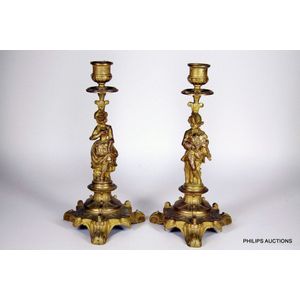French Restauration Cupid Candlesticks from Melba Collection
You must be a subscriber, and be logged in to view price and dealer details.
Subscribe Now to view actual auction price for this item
When you subscribe, you have the option of setting the currency in which to display prices to $Au, $US, $NZ or Stg.
- Cupid Motif - The Cupid motif, which features the Roman god of love and desire, Cupid, was a popular decorative element in classical ornamentation. Cupid was often depicted as a winged, naked baby with a bow and arrow, and was often used to symbolize love and desire.
In classical art and architecture, Cupid motifs were often used as decorative elements on furniture, such as on the legs of chairs and tables, as well as on architectural elements such as friezes and pediments. They were also used as decorative elements in frescoes, mosaics, and other forms of art.
During the Renaissance, Cupid motifs were often incorporated into the decoration of palaces, churches and other grand buildings, as they were seen as symbols of love and fertility. Cupid motifs were also commonly used in the decorative arts of the Baroque period, often appearing in the form of putti, which are small winged cherub figures.
In addition to their decorative use, Cupid motifs were also believed to hold symbolic meaning, as they were thought to evoke feelings of love, desire, and fertility. - Socle - The short plinth, usually cylindrical, that serves as a pedestal for a sculpture or vase
- Ormolu - Ormolu was popular with French craftsmen in the 18th and 19th century for ornamental fittings for furniture, clocks and other decorative items. True ormolu is gilt bronze, that is bronze that has been coated with gold using a mercury amalgam. Due to the health risks associated with using mercury, this method of creating ormolu was discontinued in France in the 1830s. A substitute was developed consisting of about 75% copper and 25% zinc, however it was inferior to the bronze version. It was often lacquered to prevent it tarnishing.
- Restauration Period - The Restauration period in French history refers to the years from 1815 to 1830. It followed the fall of Napoleon Bonaparte and the end of the Napoleonic Wars. During the Restauration, the Bourbon monarchy was restored to power in France with Louis XVIII as king. This period was characterized by a conservative and reactionary political climate, as the monarchists sought to undo the liberal and republican ideals of the French Revolution. The Restauration also saw the rise of industrialization and the growth of a middle class in France.
This item has been included into following indexes:
Visually similar items


A pair of bronze and gilt bronze winged Victory candelabra 20th century 45 cm high

A pair of rococo style gilt metal candelabra foliate cast stem with four arms and sconces 47.5 cm high

A pair of vintage spelter candlesticks, 20th century, the candlesticks, one with the stem in the form of a maiden in 18th century attire, the other featuring her male musician companion, both raised on tripod bases with splayed scroll feet and neoclassical
